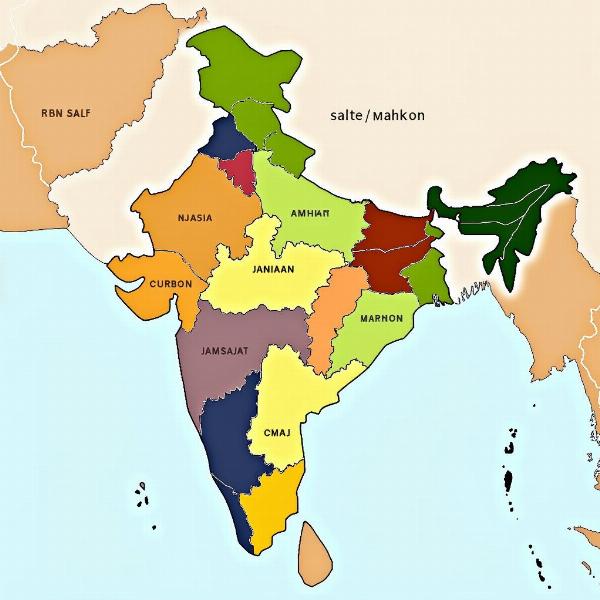Sea salt, a staple in kitchens worldwide, holds a significant place in Indian cuisine and culture. Understanding its meaning in Hindi goes beyond simple translation, encompassing its culinary uses, health benefits, and cultural significance. This article will explore “sea salt meaning in Hindi,” delving into its various aspects and providing a comprehensive understanding of this essential ingredient.
What Does Sea Salt Mean in Hindi?
The most common Hindi translation for sea salt is “समुद्री नमक” (samudri namak). “Samudri” means “marine” or “of the sea,” while “namak” means “salt.” This literal translation clearly indicates the origin of the salt. However, depending on the region and context, other terms might be used, including “kala namak” (black salt), which, despite its name, can sometimes refer to a darker variety of sea salt. This highlights the nuances of language and the importance of understanding context. Are you curious about the different types of sea salt used in Indian cooking? This article will explore those, too.
Culinary Uses of Sea Salt in India
Sea salt plays a crucial role in Indian cooking, enhancing the flavors of various dishes. From adding a salty crunch to salads to seasoning curries and preserving pickles, its versatility is unmatched. The coarse texture of some sea salt varieties makes it ideal for specific preparations, while the finer varieties are preferred for everyday cooking. For example, in South India, flaky sea salt is often used in tempering, adding a unique flavor and texture to the dish.
Regional Variations in Sea Salt Usage
Across India, the usage of sea salt varies based on regional culinary traditions. In coastal areas, where access to fresh seafood is abundant, sea salt is used generously in seafood preparations. Inland, it might be combined with other spices and used in vegetarian dishes.
 Regional Variations of Sea Salt Use in India
Regional Variations of Sea Salt Use in India
Health Benefits and Myths Surrounding Sea Salt
Sea salt is often touted for its health benefits, particularly its mineral content. It contains trace minerals like magnesium, potassium, and calcium, which are essential for various bodily functions. However, it’s crucial to note that the mineral content can vary depending on the source and processing of the sea salt. Moreover, the sodium content in sea salt is similar to table salt, so excessive consumption can still lead to health issues.
Debunking the Myths
While some claim sea salt is inherently healthier than table salt, it’s essential to approach these claims with a critical eye. The primary health concern related to salt consumption is the sodium content, which is comparable in both sea salt and table salt.
“Moderation is key when it comes to salt intake, regardless of the type,” says Dr. Anjali Sharma, a renowned nutritionist based in Mumbai. “While sea salt may offer some trace minerals, the quantities are generally not significant enough to make a substantial difference in one’s health.”
Sea Salt in Indian Culture and Traditions
Beyond its culinary applications, sea salt has cultural significance in India. In some traditions, it’s considered auspicious and used in religious ceremonies. It is also believed to have purifying properties and is sometimes used in rituals to ward off negative energy.
Conclusion: Understanding the True Meaning of Sea Salt
Understanding “sea salt meaning in Hindi” encompasses more than just its literal translation. It involves appreciating its culinary uses, acknowledging its potential health benefits while debunking myths, and recognizing its cultural significance. From enhancing flavors in Indian cuisine to playing a role in traditional practices, sea salt holds a multifaceted place in Indian life.
FAQ
- Is sea salt better than table salt? While sea salt contains trace minerals, its sodium content is similar to table salt. Moderation is key for both.
- What are the different types of sea salt used in India? Common varieties include coarse sea salt, fine sea salt, and black salt (kala namak).
- How is sea salt used in Indian cooking? It’s used in everything from seasoning curries to preserving pickles and adding flavor to salads.
- What is the cultural significance of sea salt in India? It’s considered auspicious in some traditions and used in religious ceremonies.
- Where can I buy authentic Indian sea salt? Local spice markets and online retailers specializing in Indian groceries are good options.
- Is pink Himalayan salt considered sea salt? While it’s a type of rock salt, it’s sometimes categorized alongside sea salt due to its mineral content.
- Can sea salt be used in Ayurvedic remedies? Yes, sea salt is used in some Ayurvedic practices for its purported medicinal properties.
Meaning-Hindi.in is your trusted partner for high-quality Hindi translation services. We specialize in various domains, including business, legal, technical, website localization, and academic translations. Whether you need a document translated quickly or require specialized expertise, our team of expert linguists is here to assist you. Contact us today at [email protected] or call us at +91 11-4502-7584. Meaning-Hindi.in helps bridge language barriers and connect you to the Indian market.